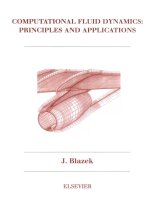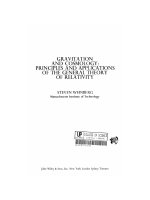- Trang chủ >>
- Khoa Học Tự Nhiên >>
- Vật lý
Optics principles and applications
Bạn đang xem bản rút gọn của tài liệu. Xem và tải ngay bản đầy đủ của tài liệu tại đây (10.43 MB, 657 trang )
OPTICS
This Page is Intentionally Left Blank
OPTICS
Principles and Applications
by
K. K. Sharma
AMSTERDAM • BOSTON • HEIDELBERG
LONDON • NEW YORK • OXFORD
PARIS • SAN DIEGO • SAN FRANCISCO
SINGAPORE • SYDNEY • TOKYO
Academic Press is an imprint of Elsevier
Academic Press is an imprint of Elsevier
30 Corporate Drive, Suite 400, Burlington, MA 01803, USA
525 B Street, Suite 1900, San Diego, California 92101-4495, USA
84 Theobald’s Road, London WC1X 8RR, UK
This book is printed on acid-free paper.
Copyright © 2006, Elsevier Inc. All rights reserved.
No part of this publication may be reproduced or transmitted in any form or by any
means, electronic or mechanical, including photocopy, recording, or any information
storage and retrieval system, without permission in writing from the publisher.
Permissions may be sought directly from Elsevier’s Science & Technology Rights
Department in Oxford, UK: phone: (+44) 1865 843830, fax: (+44) 1865 853333,
E-mail: You may also complete your request on-line
via the Elsevier homepage (), by selecting “Support & Contact”
then “Copyright and Permission” and then “Obtaining Permissions.”
Library of Congress Cataloging-in-Publication Data
Application submitted
British Library Cataloguing-in-Publication Data
A catalogue record for this book is available from the British Library.
ISBN 13: 978-0-12-370611-9
ISBN 10: 0-12-370611-4
For information on all Academic Press publications
visit our Web site at www.books.elsevier.com
Printed in the United States of America
06 07 08 09 10 9 8 7 6 5
4
3
2
1
Working together to grow
libraries in developing countries
www.elsevier.com | www.bookaid.org | www.sabre.org
Dedicated to the memory of my parents
Bliss is the inseparable
companion of knowledge
-Upanishads
This Page is Intentionally Left Blank
CONTENTS
Preface
Acknowledgements
1 LIGHT WAVES
1.1
1.2
1.3
Introduction
Maxwell’s Equations
The Wave Equation
1.3.1 Plane Wave Solution
1.3.2 Spherical and Cylindrical Wave Solutions
1.3.3 Beam-Like Solutions
1.4 Homogeneous and Inhomogeneous Waves
1.5 Energy Density and Poynting Vector
1.6 Boundary Conditions
1.6.1 Continuity of the Normal Components
1.6.2 Continuity of the Tangential Components
1.7 Reflection and Transmission at a Boundary
1.7.1 External Reflections
1.7.2 Reflectance and Transmittance
1.7.3 Internal Reflections
1.7.4 Frustrated Total Internal Reflection
1.7.5 Reflection from a Metallic Surface
1.8 Passage of Light through a Prism
1.9 Dispersion
1.9.1 Dispersion in Dilute Gases
1.9.2 Dispersion in Dense Media
1.9.3 Group and Signal Velocities
1.10 Propagation of light in Anisotropic Media
1.10.1 Fresnel Equation
1.10.2 Geometrical Constructions
1.10.3 Uniaxial Crystals
1.10.4 Biaxial Crystals
1.10.5 Double Refraction
1.10.6 Polarizing Prisms
xv
xvii
1
1
1
6
9
12
13
18
21
22
23
24
25
30
33
36
40
42
44
50
52
53
55
57
60
62
64
67
69
71
vii
viii
CONTENTS
1.11 References
1.12 Problems
2 COHERENCE OF LIGHT WAVES
2.1
2.2
2.3
2.4
2.5
2.6
2.7
2.8
2.9
Polychromatic Light
2.1.1 Quasi-monochromatic Light
Partially Coherent Light
2.2.1 Spatial and Temporal Coherence
Complex Coherence Functions
2.3.1 Stationary and Time-Averaged Fields
2.3.2 Intensity of Polychromatic Light
Self Coherence
2.4.1 Complex Degree of Self Coherence
2.4.2 Fourier Transform Spectroscopy
Mutual Coherence
2.5.1 Complex Degree of Mutual Coherence
2.5.2 Coherence of Light from an Extended Source
2.5.3 Michelson Stellar Interferometer
Van Cittert–Zernike Theorem
2.6.1 Incoherent Quasi-monochromatic Source of Circular
Cross-Section
2.6.2 Area of Coherence
Intensity Correlations
2.7.1 Hanbury Brown and Twiss Experiment
2.7.2 Photon Statistics
References
Problems
3 POLARIZATION OF LIGHT WAVES
3.1
3.2
3.3
3.4
States of Polarization
3.1.1 Linear Polarization
3.1.2 Elliptical and Circular Polarizations
3.1.3 Helicity of Light Waves
The Polarization Ellipse
Matrix Representation of Polarization States
3.3.1 The Jones Vectors
3.3.2 Jones Matrices for Linear Optical Devices
The Stokes Parameters
3.4.1 Monochromatic Light
3.4.2 Quasi-monochromatic Light
73
73
77
77
80
80
81
82
83
84
86
88
94
96
99
102
104
106
109
111
112
113
114
116
117
121
121
121
123
125
127
129
129
134
139
141
142
CONTENTS
3.4.3 Completely Unpolarized Light
3.4.4 Mixture of Mutually Incoherent Light Fields
3.4.5 Geometrical Interpretation of Stokes Parameters
3.5 The Poincaré Sphere
3.6 Mueller Matrices
3.6.1 Linear Polarizer
3.6.2 Phase Retarder
3.7 The Coherency Matrix
3.8 Pancharatnam Theorem
3.9 References
3.10 Problems
4 GEOMETRICAL OPTICS
4.1
4.2
4.3
4.4
4.5
4.6
4.7
4.8
Introduction
4.1.1 Paraxial Approximation
Ray Matrix Approach to Gaussian Optics
4.2.1 The Lens Matrix
4.2.2 Cardinal Points of a Lens
4.2.3 Ray Transformation between Principal Planes
4.2.4 Ray Matrix for Image Formation
4.2.5 Ray Tracing
4.2.6 Ray Matrix for Reflection
Optical Systems
4.3.1 Apertures and Stops
4.3.2 Single Lens Magnifier
4.3.3 Single Lens Camera
4.3.4 Two-Lens Optical Systems
4.3.5 The Microscope
4.3.6 The Telescope
4.3.7 Telephoto Lens
Optics of a Laser Cavity
Optics of the Human Eye
4.5.1 Defects of the Human Eye
Cylindrical Lens
References
Problems
5 LENS ABERRATIONS
5.1
5.2
Stigmatic Image
Aplanatic Points
ix
144
145
147
148
150
151
152
153
155
156
156
159
159
160
161
163
168
172
177
183
184
187
187
189
192
193
195
199
202
204
209
211
212
213
213
217
217
218
x
CONTENTS
5.3 Image Formation with Non-paraxial Rays
5.3.1 Tangential and Sagittal Planes
5.4 Wavefront Aberration Function
5.4.1 Ray Deviations
5.4.2 Focusing Errors
5.5 Primary Aberrations
5.5.1 Spherical Aberration
5.5.2 Coma
5.5.3 Astigmatism
5.5.4 Field Curvature
5.5.5 Distortion
5.6 Chromatic Aberration
5.7 References
5.8 Problems
6 INTERFERENCE OF LIGHT WAVES
6.1 Interference
6.2 Two-Wave Interference
6.2.1 Interference by Division of Wavefront
6.2.2 Interference by Division of Amplitude
6.2.3 Testing Flatness of Surfaces
6.3 Interference with Extended Sources
6.3.1 Haidinger Fringes
6.3.2 Fizeau Fringes
6.3.3 Newton’s Rings
6.3.4 Straight Fringes
6.4 Two-Wave Interferometers
6.4.1 Michelson Interferometer
6.4.2 Twyman–Green Interferometer
6.4.3 Mach–Zehnder Interferometer
6.4.4 Sagnac Interferometer
6.5 Multi-wave Interference
6.5.1 Intensity Distribution in Multi-wave
Interference
6.6 Fabry–Perot Interferometer
6.6.1 Widths of Transmission Peaks
6.6.2 Fabry–Perot Interferometer as a Spectrometer
6.6.3 Free Spectral Range
6.6.4 Spectral Resolution
6.7 Lummer–Gehrcke Plate
6.8 Thin Optical Coatings
219
221
222
226
228
230
230
234
241
246
248
249
252
252
255
255
256
261
263
266
268
269
271
272
274
275
275
280
282
283
283
285
289
291
293
296
297
300
301
CONTENTS
6.8.1 Single Layer Optical Coatings
6.8.2 Multi-layer Optical Coatings
6.8.3 Anti-Reflection Coatings
6.8.4 High Reflectance Coatings
6.8.5 Narrow Band Interference Filters
6.9 References
6.10 Problems
7 DIFFRACTION OF LIGHT
7.1
7.2
7.3
7.4
7.5
7.6
7.7
7.8
Introduction
Huygens’ Principle
Huygens–Fresnel Theory
Kirchhoff ’s Diffraction Theory
7.4.1 Kirchhoff ’s Boundary Conditions
7.4.2 Fresnel–Kirchhoff Diffraction Formula
Regimes of Diffraction
Babinet’s Principle
References
Problems
8 FRESNEL DIFFRACTION
8.1
8.2
8.3
8.4
8.5
8.6
8.7
Near-Field Diffraction
Rectangular Aperture
8.2.1 The Cornu Spiral
8.2.2 Narrow Slit
8.2.3 Straight Edge
8.2.4 Rectangular Obstacle
Circular Aperture
8.3.1 Irradiance at Off-Axial Points
8.3.2 The Arago Bright Spot
The Zone Plate
Pin-Hole Camera
References
Problems
9 THE FOURIER TRANSFORM
9.1
9.2
Introduction
The Fourier Series
9.2.1 The Rectangle Wave
xi
301
305
312
313
314
315
316
319
319
320
321
322
325
327
333
335
337
338
339
339
341
344
346
353
355
359
364
365
366
369
370
370
373
373
373
375
xii
CONTENTS
9.3
9.4
9.5
9.6
9.7
9.8
9.9
10
11
Fourier Transforms in One Dimension
9.3.1
Fourier Transforms of Simple Functions
Fourier Transforms in Two Dimensions
9.4.1
Properties of the Fourier Transforms
Convolution Operation
9.5.1
Convolution as the Area of Products
9.5.2
Convolution and Impulse Response
9.5.3
Convolution Theorems
Convolution of Discrete Functions
Correlation of Functions
9.7.1
Correlation Theorems
9.7.2
The Wiener–Khinchin Theorem
References
Problems
379
382
389
389
392
395
397
399
402
403
405
406
407
407
FRAUNHOFER DIFFRACTION
411
10.1
Far-Field Diffraction
10.1.1 Fourier Decomposition of Aperture Function
10.1.2 Diffraction with a Lens
10.2
Diffracting Apertures
10.2.1 Rectangular Aperture
10.2.2 Infinitely Long Slit
10.2.3 Circular Aperture
10.3
Apodization
10.4
The Array Theorem
10.4.1 Two-Slit Aperture
10.4.2 Three-Slit Aperture
10.5
The Diffraction Grating
10.5.1 Grating Dispersion
10.5.2 Blazed Grating
10.5.3 Resolving Power of a Grating
10.5.4 Free Spectral Range
10.6
Irregularly Positioned Apertures
10.7
Sinusoidal Grating
10.8
Two Pin-Holes
10.9
References
10.10 Problems
411
413
414
419
419
421
423
427
429
431
434
436
440
440
445
449
450
451
452
454
454
IMAGE FORMATION AND OPTICAL PROCESSING
459
11.1
11.2
459
461
Introduction
Diffraction Theory of Image Formation
CONTENTS
11.3
11.4
11.5
11.6
11.7
11.8
11.9
12
13
11.2.1 Image Formation with one Lens
11.2.2 Image Formation with Two Lenses
Coherent Image Processing
11.3.1 Spatial Frequency Filtering
11.3.2 Filters for Imaging Phase Objects
11.3.3 Complex Filter
11.3.4 Matched Filter
Coherent Optical Processing
Incoherent Image Formation
Incoherent Optical Processing
Resolving Power of Image Forming Systems
11.7.1 Incoherent Object Illumination
11.7.2 Coherent Object Illumination
References
Problems
xiii
463
471
473
473
478
481
487
488
489
490
493
493
495
498
498
TRANSFER FUNCTIONS
505
12.1
12.2
12.3
12.4
12.5
12.6
Introduction
Isoplanatism
Coherent Transfer Function
Optical Transfer Function
OTF of a Diffraction-limited Optical System
Transfer Functions of Aberrated Optical Systems
12.6.1 OTF of a Defocused Optical System
12.7 Imaging Sinusoidal Object Modulation
12.8 Measurement of OTF
12.9 References
12.10 Problems
505
506
507
510
512
517
519
521
524
525
525
HOLOGRAPHY
529
13.1
13.2
529
531
531
534
538
542
546
551
553
554
558
13.3
13.4
13.5
13.6
13.7
Introduction
On-Axis Holography
13.2.1 Hologram Recording
13.2.2 Wavefront Reconstruction
Off-Axis Holography
Holography of 3D Objects
Magnification in Holographic Imaging
13.5.1 Lensless Fourier Transform Hologram
13.5.2 Resolution of a Hologram
Reflection Hologram
Rainbow Holography
xiv
14
CONTENTS
13.8
Holographic Interferometry
13.8.1 Double Exposure Holographic Interferometry
13.8.2 Real-Time Holographic Interferometry
13.8.3 Time-Average Holographic Interferometry
13.9
Holographic Optical Elements
13.10 References
13.11 Problems
560
561
563
564
566
567
567
NONLINEAR OPTICS
571
14.1
14.2
571
573
575
582
582
585
585
586
588
590
591
593
599
601
606
609
613
615
618
621
623
624
624
Introduction
Nonlinear Polarization
14.2.1 Second-Order Nonlinear Polarization
14.2.2 Third-Order Nonlinear Polarization
14.2.3 Higher Order Nonlinear Polarizations
14.3
Symmetry Properties of the Susceptibility Tensors
14.3.1 Susceptibility Tensors for Negative Frequencies
14.3.2 Full Permutation Symmetry
14.3.3 Kleinman’s Symmetry
14.4
Wave Equation for Nonlinear Media
14.5
Second-Order Nonlinear Processes
14.5.1 Sum-Frequency Generation
14.5.2 Upconversion
14.5.3 Second-Harmonic Generation
14.5.4 Parametric Amplification
14.6
Optical Phase Conjugation
14.7
Optical Kerr Effect and Self-Focusing
14.8
The Electrooptic Effect
14.9
Electrooptic Modulators
14.9.1 Electrooptic Intensity Modulator
14.9.2 Electrooptic Phase Modulator
14.10 References
14.11 Problems
Appendix-A
Appendix-B
Index
627
629
631
PREFACE
The driving force to write a book is the urge in author’s mind to present his/her way
of treating the subject matter. In the process, the book may succeed in emphasizing
aspects which may or may not have received due attention. Excellent books on optics
exist. For example, Principles of Optics by Max Born and Emil Wolf contains practically everything that a book on classical optics should have. Today, optics may be
as relevant to engineering students as to students of physics. This textbook, an outcome of my experience of teaching optics courses at Indian Institute of Technology
Kanpur, strives to meet the needs of both streams of students. Not that other authors
have not paid sufficient attention to this aspect, the emphasis and visibility of topics
may, however, differ from book to book. Admittedly, a textbook on optics cannot
over-emphasize topics of engineering interest without compromising on basics of
optics. Pedagogy is the other thought process that has guided the preparation of the
manuscript. The collection and sequencing of the material have been done to ensure
continuity in the learning process. By and large, all selected topics have been treated
rigorously, in depth, and as far as possible completely. Motivated students should
benefit through self-study, but teacher’s exposition is perhaps essential. The book
is primarily aimed for senior undergraduate and beginning postgraduate students.
Students at that level with sufficiently advanced skills may not need solved examples and illustrations. However, first few problems of most chapters are relatively
easy and should essentially serve that purpose.
Consulting different books is an enriching experience for students and teachers
alike, but availability of a textbook which can delineate broad outlines of a
course or courses may be desirable. Leaving a few topics and emphasizing
some others should provide the necessary flexibility to adopt this textbook for
different courses on optics, applied optics, and photonics. The reader may find
sequencing of some topics a bit unusual. Coherence of light, for example, is
taken up much before diffraction. This is to make students realize that real light
is polychromatic and only partially coherent. Treating light through plane waves
throughout the book and bringing in polychromaticity and partial coherence
towards the end defeats this purpose. Introducing coherence early on puts students
in an advantageous position to deal with real light in basic optics, as for example
in interference studies.
As in other fields, consistency and uniqueness of notations do not exist in optics.
My choice of notations may reflect personal bias and quite possibly may not be
xv
xvi
PREFACE
the choice of the majority in the field. I have, however, tried to use simple and
consistent notations, but at times deliberate departures could not be avoided. With
very few exceptions, function variations shown in the book are actual plots drawn
on MATLAB. The figures are drawn using Xfig software. The book contains eight
original photographs besides three photographs (Figs. 11.10, 13.22, and 13.24)
borrowed from literature, for which I am indebted to the original authors and publishers. Wherever I leaned substantially on a certain approach, original authors are
acknowledged. I apologize for inadvertent omissions. Most derivations in the book
are sufficiently detailed. Utmost care was exercised to eliminate errors, but this
cannot be guaranteed. Hopefully, serious mistakes should not be too many. Effort
has been made, as far as possible, to make each chapter self contained.
Chapter 1 deals with light propagation in isotropic and anisotropic media. This
is a bit of a departure from tradition. Usually, light propagation in anisotropic
media is considered much later. Anisotropic media, however, provide a more
general (and beautiful) example of light propagation and their discussion at this
stage seems quite appropriate. Likewise, coherence of light waves is introduced
in Chapter 2 to help develop a realistic appreciation of real light at an early stage.
Elementary knowledge of Fourier transforms and Fraunhofer diffraction should
suffice to follow the contents of this chapter. Chapters 3–8 cover bulk of standard linear optics except Fraunhofer diffraction which is taken up in Chapter 10.
The Jones vectors, Stokes parameters, matrix techniques for the description of
optical instruments and laser resonators, lens aberrations, two- and multi-wave
interference, thin optical coatings, diffraction theories, and Fresnel diffraction
are among the topics discussed in these chapters. Chapters 10–13 on Fraunhofer
diffraction, image formation and processing, transfer functions, and holography
may constitute the section on Fourier optics. Fourier transforms, convolution and
correlation operations, needed for the discussions in these chapters are reviewed
in Chapter 9. Nonlinear optics is introduced in the last chapter (Chapter 14)
of the book. First twenty five pages of this chapter develop fairly rigorously
the theoretical framework, followed by a discussion on some of the commonly
observed nonlinear effects such as the sum-frequency generation, upconversion,
second-harmonic generation, parametric amplification and optical phase conjugation. The chapter ends with a discussion on optical Kerr and electrooptic effects.
Each chapter has a set of problems which should help students extend their
working knowledge of optics. Major omissions of the book include fiber optics,
lasers, and quantum optics. Full justification to these topics without substantially
increasing the size of the book is not possible, hence their exclusion.
K K Sharma
Panchkula, India
2006
(Formerly at Indian Institute of Technology Kanpur)
ACKNOWLEDGEMENTS
First of all, I wish to acknowledge students of my optics courses over the years
because the inspiration to write the book came from my interaction with them.
My many colleagues at Indian Institute of Technology Kanpur must be thanked
for their encouragement. David Joseph deserves special thanks for help at different stages of manuscript preparation. Sandhya Agnihotri showed exceptional
patience in typing and re-typing (in LaTeX) many revisions of the manuscript. I
express my gratitude to her. Thanks are also due to Shikha, Seema, and Atul for
typing the difficult chapter on nonlinear optics. I am grateful to Vivek Mishra
and Sachin Ganu for MATLAB work, to Harjeet and Ruchika for Xfig drawings,
to David Joseph for setting diffraction experiments, to Om Prakash for workshop
assistance, and to the staff of the TV Centre of the Institute for photography.
I am indebted to Greg Gbur for a careful reading of the manuscript and for
his suggestions. I acknowledge my gratitude to Indian Institute of Technology
Kanpur for providing facilities and congenial environment. I am thankful to the
Department of Science and Technology, New Delhi for financial support during
the latter phase of book-writing. Most of all, I thank my wife Tripta not only
for her immense patience and forbearance, but also for keeping me free from
family tasks so that I could remain focused on this endeavor. I cherish the moral
support I have recieved from my extended family, our children Shikha, Seema,
Atul, and Anjali, and also from Amit and Sachin. The smiles from Neha and
Arushi helped to cheer me up when there were reasons to feel otherwise. I put
on record the pleasure of interacting with Tim Pitts, Rachel Roumeliotis, Brand
Lilly and Priyaa H Menon of the editorial staff of Elsevier. There is a long list
of individuals who have helped me in many ways, I thank them collectively.
xvii
This Page is Intentionally Left Blank
CHAPTER
1
Light Waves
1.1 INTRODUCTION
Visible light constitutes a small, albeit an important, segment of the broad spectrum of electromagnetic waves encompassing -rays on one extreme and radio
waves on the other. Between these two extremes, lie X-rays, ultraviolet radiation,
visible light, infrared radiation and microwaves in decreasing order of frequency
(Table 1.1). At the present stage of development of the field of optics, it is really
not necessary to justify the wave nature of light. Having said that, it must also be
mentioned that the original controversy between the two protagonists (Sir Issac
Newton and Christian Huygens) representing two schools of thought – light being
corpuscular and light having wave nature – took a new twist with the development of quantum mechanics. Light, like matter, is now understood to have a dual
character – the wave-like behavior as well as the particle-like (photon) behavior.
Both attributes may not be revealed in a single measurement. Broadly speaking,
light propagation in free space and in other media can be described in classical
terms whereas light–matter interaction (absorption and emission of light) can be
understood only in the quantum mechanical description. In this book, we are
primarily concerned with light propagation and hence the classical description
in terms of Maxwell’s equations is quite adequate. Maxwell’s equations predict
the velocity of propagation of electromagnetic waves in vacuum which is in
close agreement with the measured velocity of light. This observation firmly
establishes light in the realm of the electromagnetic waves.
1.2 MAXWELL’S EQUATIONS
All electromagnetic phenomena, including light propagation, can be fully
described in terms of Maxwell’s equations (written here, in the SI units):
· E= /
0
· B=0
1
2
Chapter 1: LIGHT WAVES
Table 1.1. The electromagnetic spectrum.
Spectral Region
Approximate Frequency Range
>1020 Hz
1017 −1020 Hz
1015 −1017 Hz
3 5−7 5 × 1014 Hz
1012 −1014 Hz
109 −1012 Hz
<109 Hz
Gamma rays
X-rays
Ultraviolet
Visible
Infrared
Microwaves
Radiofrequency
×E=−
×B=
where
0
and
0
0
B
t
⎛
⎝J +
⎞
0
E⎠
t
(1.1)
are, respectively, the permeability and permittivity of vacuum;
and J are the charge and current densities, respectively.
There is a need to distinguish between the microscopic and macroscopic forms
of Maxwell’s equations. The charge and current densities in the microscopic
form of Maxwell’s equations are those which exist at the atomic level. Consequently, the electric field E and magnetic field B are expected to show rapid
variations over atomic and subatomic distances. Visible light with wavelength
range between 400 and 800 nm cannot probe the charge and current distributions
at the atomic level. X-rays and -rays with much shorter wavelengths are better
suited to probe atomic distributions. Light waves can provide information on
charge and current distributions in matter averaged over distances of the order
of the wavelength of light. In that sense, light is a rather crude probe to interrogate matter at the atomic level. Light waves perceive a medium more like a
continuum, and not a medium packed with discrete particles. The macroscopic
form of Maxwell’s equations uses the charge and current densities which are
averaged over microscopically large, but macroscopically small volumes. Macroscopically averaged fields vary smoothly in space and are mathematically well
behaved. The Gauss and Stokes vector theorems can be applied to these fields.
In this book, we shall deal with the macroscopic form of Maxwell’s equations.
Maxwell’s equations in the differential form (Eq. 1.1) can be derived from the
empirical integral formulation of the laws of electromagnetism developed over
centuries by Gauss, Ampère, Faraday and others. Maxwell brought symmetry
to these equations by introducing the displacement current density 0 E / t. No
wonder, these equations are known as Maxwell’s equations. In the context of the
1.2: MAXWELL’S EQUATIONS
3
macroscopic form of Maxwell’s equations, it is necessary to distinguish between
the free and bound charge and current densities. The free electrons in conductors
generate the free charge density f . In addition, it may also happen that the
centers of the positive and negative charges in a small macroscopic volume may
not coincide. If this happens, an electric dipole moment can be associated with
this volume and the medium is said to be polarized. The electric polarization P
is defined as
P=
net electric dipole moment in a macroscopically small volume V
volume V
(1.2)
The bound charge density in a polarized medium is given by
b
=− · P
(1.3)
The bound charge density b is non-zero only if polarization P is spatially
changing. Electric polarization can be created in a medium either by aligning its
polar molecules or by displacing its negative charge with respect to the positive
charge by the application of an external electric field. The movement of the
free charges in a conductor gives rise to the free current density J f , and the
changing displacements of the bound charges from their equilibrium positions
give rise to the bound current density
Jb =
dP
dt
We should also recognize the existence of the magnetic dipole moments in
magnetic materials. The bound current density can be generalized to include
these contributions as well;
Jb=
dP
+ ×M
dt
(1.4)
where magnetization M is the magnetic moment per unit volume defined in
the manner of Eq. (1.2). We now write Maxwell’s equations indicating these
contributions explicitly:
· E=
· B=0
f
+
b
/
0
(1.5a)
(1.5b)
4
Chapter 1: LIGHT WAVES
×E=−
×B=
0
B
t
⎛
(1.5c)
⎞
⎝Jf + Jb +
0
E⎠
t
(1.5d)
These equations along with the defining equations for the bound charge and
bound current densities constitute a formidable set of equations to deal with.
They can be made more compact by introducing two additional fields,
D=
H=
0
E+P
(1.6a)
−M
(1.6b)
B
0
where D is the electric displacement field and H is the magnetic field. The field
B is usually called the magnetic induction or the magnetic flux density. The
term magnetic field is often used to refer either of the B or H field. Maxwell’s
equations (Eqs 1.5) can now be put in the form:
· D=
(1.7a)
f
· B=0
×E=−
(1.7b)
B
t
× H = Jf +
(1.7c)
D
t
(1.7d)
Despite the presence of the source terms, Maxwell’s equations should not be
conceptualized in terms of the cause and effect, where the fields are determined
by the sources of the charge and current present in the medium. The sources
and fields are, in fact, inter-dependent – each affecting the other. True, the free
charges do not depend on the fields, but the bound charges and currents are field
dependent. The bound charges and currents change the fields and are in turn
modified by the changing fields.
Equations (1.7) appear deceptively simple but are actually unmanageable primarily because, notwithstanding Eqs (1.6), no simple relationships exist between
the electric fields E and D and between the magnetic fields B and H. Fortunately, the elementary magnetic moments are not of much concern at the optical
1.2: MAXWELL’S EQUATIONS
5
frequencies. Consequently, the magnetization M can be ignored and the relationship between the B and H fields for materials of optical interest is rather
simple:
B=
H
The permeability of optical materials is essentially field independent and differs
only slightly from vacuum permeability 0 . However, the electric polarization
P must be reckoned with and cannot be ignored. In the absence of a detailed
understanding in classical terms, the electric polarization P is usually expanded
as a power series in the electric field:
Pi =
0
1
ij
Ej +
2
ijk Ej Ek +
3
ijkl Ej Ek El + · · ·
(1.8)
where Ei , Ej , Ek are the components of the electric field contributing to the
ith component of the polarization P. The coefficients n with n = 1 2 3
are the electric susceptibility tensors describing intrinsic material properties and
are best understood in quantum mechanical terms. Alternatively, they may be
treated as parameters to be determined empirically. Equation (1.8) is actually
more complicated than it appears because the polarization P at a certain spacetime point r t may depend, in addition to field E at point r and time t, on
fields in the spatial neighborhood of this point and may also depend on fields at
times prior to the chosen time t. We shall ignore such complications. Here, we
assume polarization P r t to depend linearly on the local and instantaneous
field only. Hence, we can write
P r t =
1
0
E r t
(1.9a)
This is the regime of linear optics to which most of this book is devoted. The
remaining terms in Eq. (1.8) form the basis of the exciting field of nonlinear
optics (Chapter 14). Equation (1.9a) is equivalent to
D r t = E r t
(1.9b)
where
=
0
1+
1
is the medium permittivity. Except for vacuum
1
and permittivity
(1.9c)
1
= 0 , the linear susceptibility
are in general complex suggesting the polarization P and
6
Chapter 1: LIGHT WAVES
displacement field D do not always remain in phase with the electric field E.
For conducting media, the so-called constitutive relations (Eqs 1.6) need to be
supplemented by
J=
E
(1.6c)
where is the electrical conductivity of the medium. A homogeneous medium is
characterized by constant values of , and , and an inhomogeneous medium
admits changes in these quantities from point to point in a smooth manner. For
linear optical materials
form:
f
= 0 J f= 0
= 0 , Eqs (1.7) can be re-cast into the
· E=0
(1.10a)
· B=0
(1.10b)
×E=−
×B=
B
t
E
t
(1.10c)
(1.10d)
We note that for linear optical materials, only two fields E and B need to be dealt
with, but the permittivity and to some extent the permeability are unknown
quantities to be determined with reference to experimental observations. It must
be appreciated that the averaging process has transferred the information on the
electromagnetic behavior of the medium at the atomic level to the macroscopic
or bulk properties of the medium – the permittivity and permeability in the
context of optical materials.
All electromagnetic fields including the light fields must be consistent with
Maxwell’s equations, but on their own these equations do not suggest the existence of fields of any particular kind. One needs to postulate specific forms of
the fields and then obtain conditions for their existence. Another point to be
noted is that these equations describe relationships for the spatial and temporal
variations of the fields, but do not provide any clue as to how these fields are
generated in the first place.
1.3 THE WAVE EQUATION
The electric and magnetic fields appear coupled in Maxwell’s equations. It is
possible to de-couple them. The decoupling process brings out some of the most









